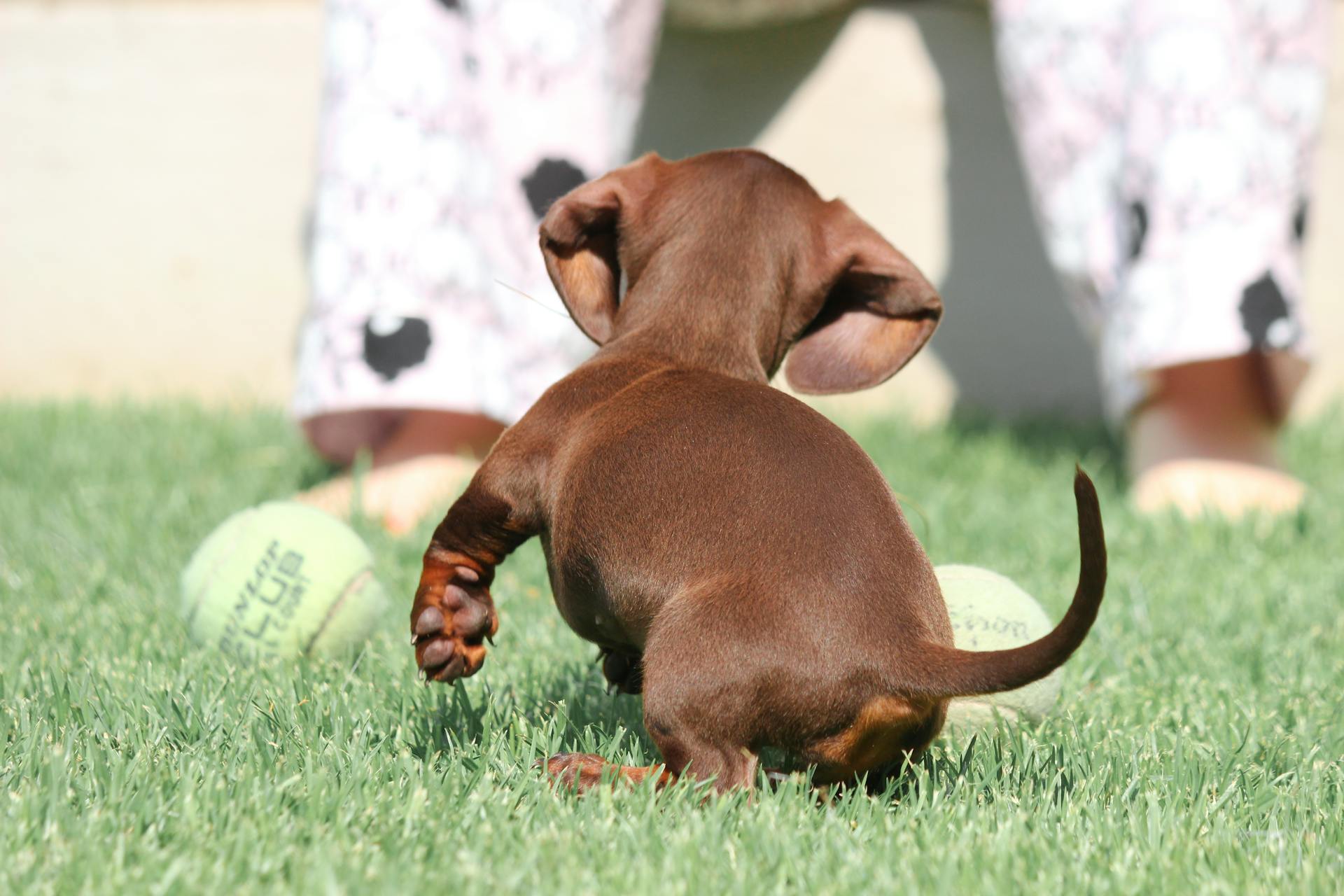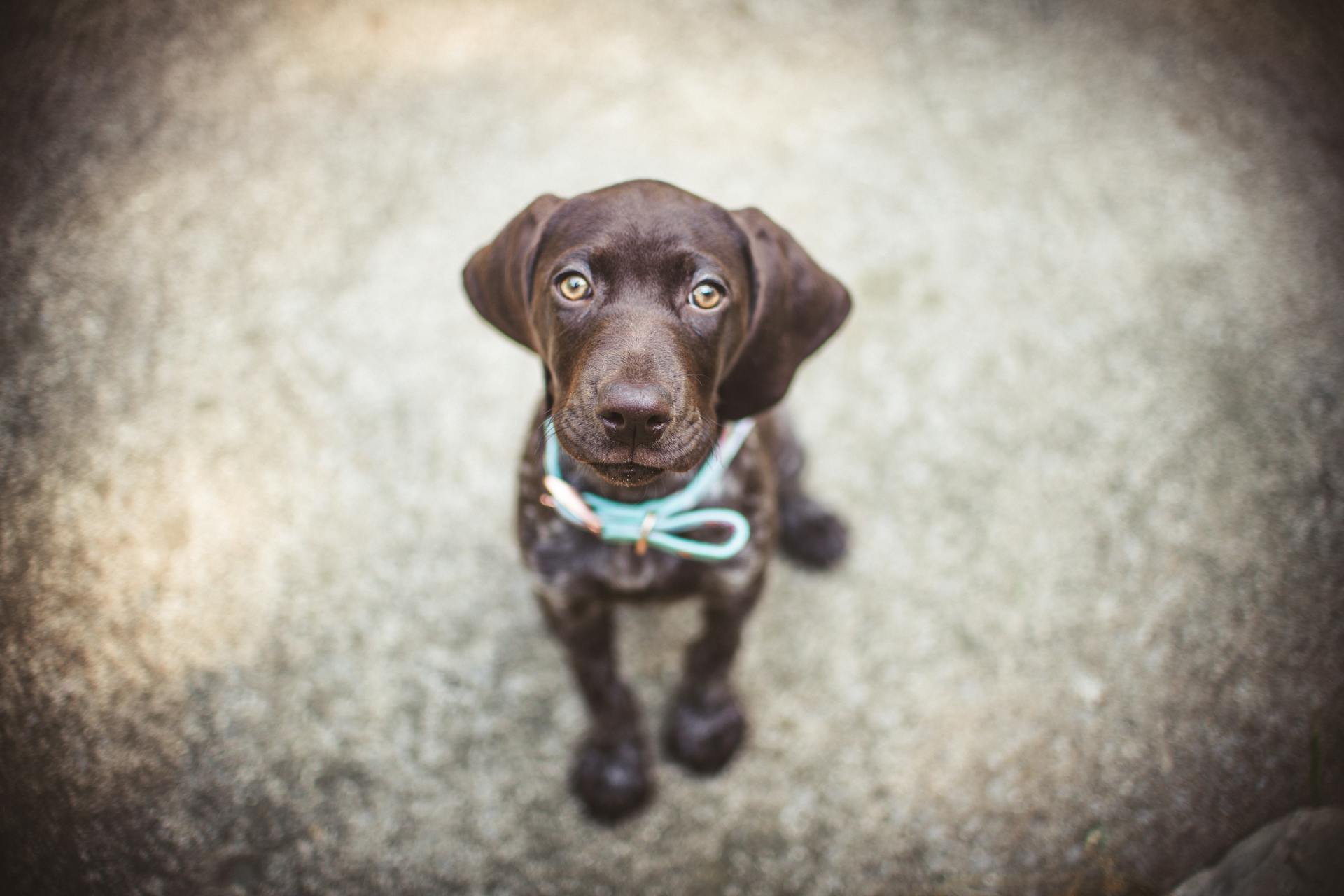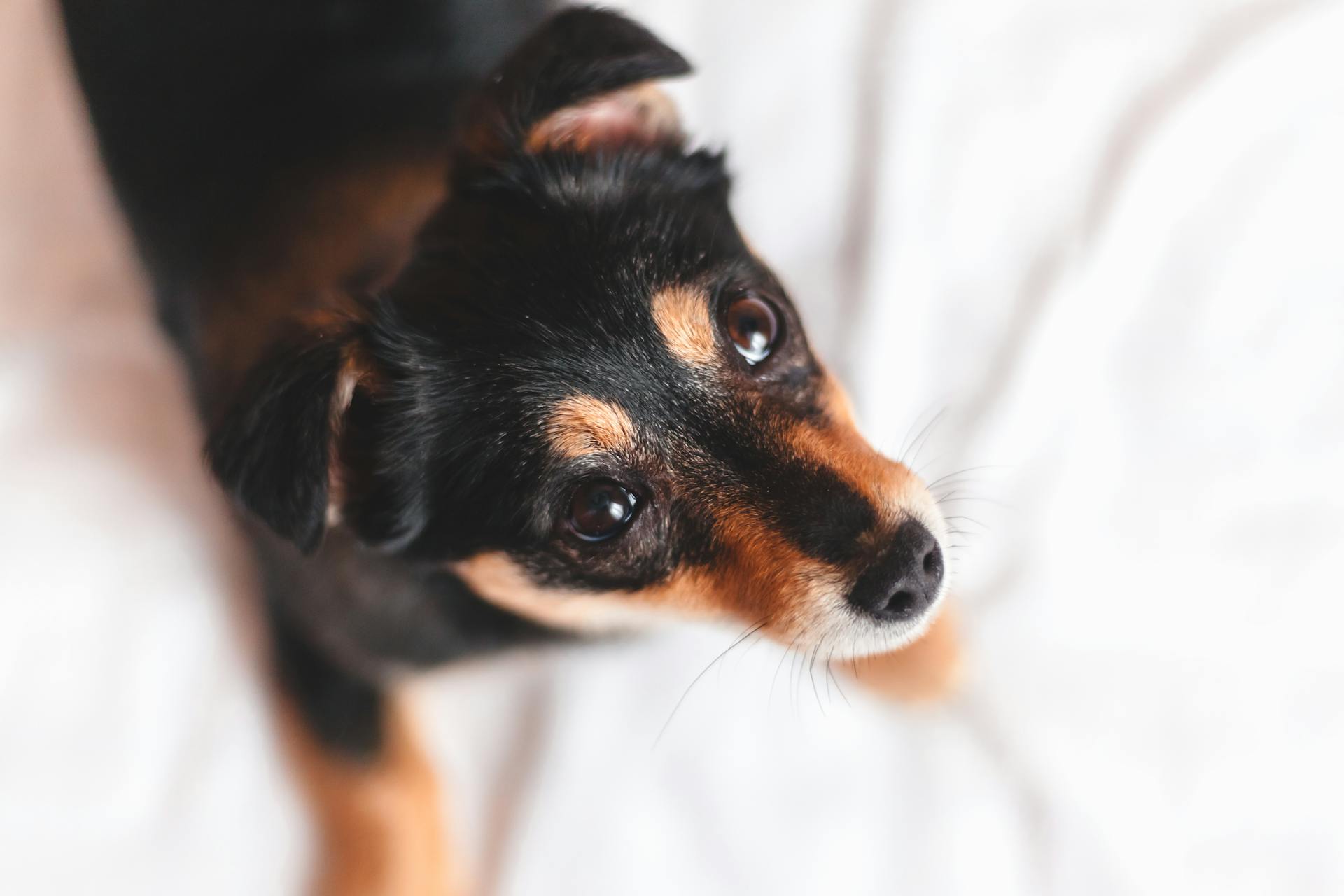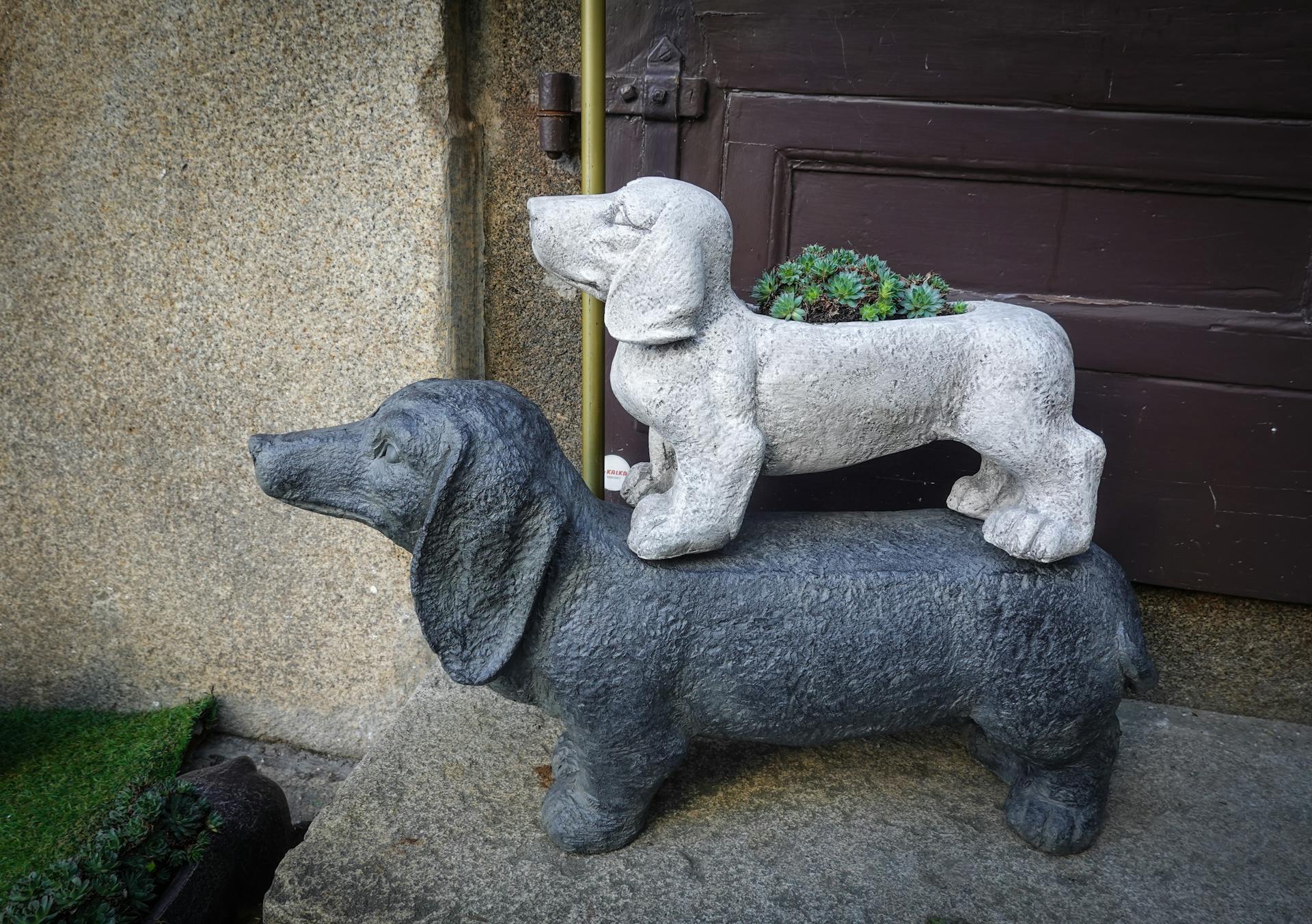
Dapple piebald Dachshunds are a unique and beautiful breed. They have a distinctive coat pattern featuring a mix of dapple and piebald markings.
Their dapple pattern is caused by a specific genetic variation that affects the production of melanin, resulting in a mottled or marbled effect on their fur. This pattern can appear in various shades, including black, chocolate, and red.
Piebald Dachshunds, on the other hand, have a predominantly white coat with patches of color. Their piebald pattern is also a result of genetic variation, which affects the distribution of melanin in their skin.
History and Origin
Dachshunds originated in Germany in the 15th century, where they were used as hunting dogs.
Their name "badger dog" resulted from their previous hunting role, which involved chasing badgers and foxes into burrows.
The unique appearance of Dachshunds, characterized by long bodies and short legs, made it easy for them to hunt successfully.
Their high intelligence made them perfect for hunting even larger animals, as they would easily outsmart other creatures.
Explore further: Mini Dachshund Hunting
The breeding of Dachshunds came about because owners began to favor the piebald pattern, leading breeders to start breeding specific types of coats.
Modern Dachshunds are not hunting dogs but are kept at home as pets, yet they still maintain their hunting instincts.
Dachshunds have athletic bodies, are courageous, and are always alert, typical of a hunting dog.
They are friendly to other animals and humans as long as the other party doesn’t pose any threat.
Related reading: Double Dapple Dachshund Breeders
Breed Characteristics
A piebald Dachshund has a solid one-colour or two-colour base coat with big areas of white.
Their markings are often symmetrical on both sides of the Dachshund's head and body, and can appear as big patches of the base colour on a white background.
Most piebalds will have at least 80% of their coat covered with white fur.
They can have white fur on their head as long as it's less than 50% and doesn't cover their ears or around his eyes.
See what others are reading: Do Dachshunds Have Hair or Fur
The Genetics
Piebald and dapple Dachshunds are two distinct patterns, and understanding their genetics can help you make informed decisions when breeding or selecting a puppy.
Piebald is a recessive gene, which means both parents need to have it in their genetic makeup for their litter to be entirely piebald.
Dapple, on the other hand, is a dominant gene, and one parent needs to be a Dapple Doxie for their offspring to have a chance of being dapple as well.
Here's a comparison of the two patterns in a table:
This knowledge can help you make informed decisions when selecting a puppy or breeding Dachshunds.
Size
Piebald Dachshunds come in two main size variants: standard and miniature. The standard variant grows to about 8 to 9 inches tall.
Mature males can grow up to 9 inches tall, while females typically top out at 8 inches.
The weight of adult Piebald Dachshunds tends to remain the same for both males and females, ranging from 16 to 32 pounds.
Miniature Piebald Dachshunds are significantly smaller, growing up to about 5 to 6 inches tall, with a weight of up to 11 pounds.
Discover more: How Much Should a Mini Dachshund Weigh
Physical Traits
A Piebald Dachshund's physical traits are quite unique and easy to spot. They have a solid one-colour or two-colour base coat with big areas of white.
Their markings are often symmetrical on both sides of the head and body, making them look like they're wearing a special coat. The exact pattern can vary from one Dachshund to another.
Piebalds typically have at least 80% of their coat covered with white fur, and they often have white fur on their head, but it should be less than 50% to be considered a true Piebald.
Their tails usually have a white tip, and their paws have white fur with white or partly white nails. Brown or dark eyes are common, but not blue - that's a trait reserved for double dapples and dilutes.
Here are the key differences between Piebald and Dapple Dachshunds:
- True Piebald Doxies can’t have blue peepers, while those are actually quite common among Dapples.
- In terms of the coat color, a Dapple Wiener may flaunt various shades of any accepted hue sprinkled all over their body, and neither shade has to dominate the other. Pied Dachshunds must have solid-colored patches.
Piebald Dachshunds need to have pigmented spots on their body and an uninterrupted patch around their eyes and over their entire ears. A white blaze between their eyes is allowed, and their tails must show white tips without exception, which is known as “Irish spotting.”
Broaden your view: White Dapple Dachshund
Are Purebred?
Purebred Piebald Dachshunds are commonly found, but that doesn't mean all Piebald breeds are purebred.
Dachshunds are the ones that are often purebred, but you can still find other species too.
Not all Piebald breeds are purebred because breeders often try to play around with different patterns.
What Is Temperament?
Dachshunds are known for their jolly temperament, making them a joy to be around and a great addition to any household.
They're social dogs that thrive on interaction, so it's essential to socialize them early on to ensure they're open to visitors and strangers.
Dachshunds were bred to hunt badgers, which means they have a strong prey drive and will always be on the lookout for small animals to chase.
Their curious streak can be both a blessing and a curse, as it can lead to them digging up your yard or getting into mischief.
Barking is another characteristic of Dachshunds - they're loud, and you can expect your neighbors to notice their presence.
To minimize barking, keep your pup busy at all times and take them out regularly to discourage excessive yapping.
Health and Grooming
Piebald Dachshunds are generally healthy dogs, but like any other dog, they can get a few health issues here and there. Most of their health issues are the same as other Dachshunds varieties.
They may suffer vision impairment issues which can lead to blindness, especially those holding the dapple genes. Eye problems common with this breed include cataracts and glaucoma.
Piebald Dachshunds are also at risk of becoming deaf a few weeks after birth. If you breed two piebald Dachshund with the dapple gene, they'll be more at risk of hearing impairment.
To minimize shedding and keep your house clean, you have to control the shedding by brushing the coat. Brushing once a week is enough to remove loose hair.
Piebald Dachshunds are not too demanding when it comes to grooming since they're moderate shedders. However, the fact that they shed makes it necessary to brush their coats from time to time to control the shedding.
Other grooming needs include giving them a bath once in six to nine weeks, trimming their nails, and cleaning their ears once in a while.
Recommended read: Dapple Dachshund Health Problems
Life Expectancy
Piebald Dachshunds are known to live a relatively long life, typically ranging from 12 to 16 years. Regular checkups with the vet can help identify any potential health issues early on.
Taking good care of your Piebald Dachshund is crucial to ensuring they live a long and healthy life. This includes feeding them nutritious dog food to maintain their overall health.
Maintaining your dog's physical fitness through regular exercise, such as a daily run, can also contribute to their longevity.
Worth a look: Wiener Dog with Spots
Common Health Problems
Piebald Dachshunds are generally healthy dogs, but they can be prone to certain health issues. Eye problems are common in this breed, including vision impairment, cataracts, and glaucoma.
Their coloring can also increase the risk of hearing impairments, with some Piebald Dachshunds becoming deaf a few weeks after birth. If you breed two Piebald Dachshunds with the dapple gene, they'll be more at risk of hearing impairment.
Back and joint issues are also a concern, particularly as the dogs get older. They may experience a spine condition called intervertebral disc disease (IVDD), which can cause pain and paralysis.
Worth a look: Are Dachshunds Good Dogs
Ear infections are another issue, due to the breed's floppy ears. Regular ear cleaning can help prevent infections.
Here are some common health issues that Piebald Dachshunds may face:
- Intervertebral Disc Disease (IVDD)
- Obesity
- Bloat
- Acanthosis Nigricans
- Eye problems (cataracts, glaucoma, Progressive Retinal Atrophy)
- Teeth issues (plaque buildup, tooth loss)
- Coat and skin issues (dry skin, coat ailments)
- Seizures
Grooming Needs
Piebald Dachshunds are moderate shedders, which means they need occasional brushing to control shedding.
Weekly brushing is enough for short-haired Piebald Dachshunds, but wire-haired and long-haired ones need more frequent brushing.
You can brush your Piebald Dachshund's coat once a week to remove loose hair and minimize shedding.
Short-haired Piebald Dachshunds only need weekly brushing, while wire-haired and long-haired ones need daily brushing to keep their coats under control.
Professional grooming is not always necessary, but you can take your Piebald Dachshund to the groomer once in a while for a trim or hand stripping.
A bath every six to nine weeks is also a good idea, along with regular nail trimming and ear cleaning.
Brushing your Piebald Dachshund's coat regularly can help keep your house clean and reduce shedding.
If this caught your attention, see: Red Dapple Long Haired Dachshund
Are Rare?
Piebald Dachshunds used to be quite rare, but many breeders in the US are now able to produce piebald puppies.
The American Kennel Club has specific guidelines for what's acceptable in the piebald pattern to reduce the risk of breeding puppies with health problems.
Breeders have to be careful with how much white fur the Dachshund has to avoid health issues.
You won't see many piebald Dachshunds in the UK, as they're not accepted under the Kennel Club's Breed Standard.
The UK Kennel Club is strict on Dachshunds with white coats because the gene that causes white fur is often linked to health problems.
If you're looking to buy a piebald Dachshund, use a reputable breeder who follows the Kennel Club's guidelines to ensure the puppy's health is being looked after.
For more insights, see: Breeding Dachshunds
Pied Bird Grooming Needs
Pied birds, like dogs, need regular grooming to stay healthy and look their best. Regular brushing is a must to prevent tangles and keep their feathers neat.

Small birds are prone to tooth decay, just like small dogs, so make sure to give their beaks a thorough cleaning several times a week. This will help prevent any health issues.
Their beaks may not need as much attention as dogs' teeth, but it's still important to clean them regularly to keep them in good condition.
Explore further: Dachshund Dogs
Care and Training
Training a Dapple Piebald Dachshund requires patience and calmness due to their independent nature and tendency to be stubborn.
They are highly intelligent and can quickly understand commands, but it's essential to start training as soon as they come home as puppies to prevent destructive behavior.
Positive reinforcement is a great way to encourage them to comply with training, and firmness is also necessary to establish obedience.
Enrolling them in a puppy training school can be beneficial, as professionals can handle them better and teach obedience and social skills.
Potty training can be challenging, but it's crucial to begin the process from an early age to avoid accidents and establish good habits.
Training a Dapple Piebald Dachshund?
Training a Dapple Piebald Dachshund requires patience and calmness due to their independent nature and tendency to be stubborn sometimes.
They're highly intelligent, making them easy to train, but this also means they can quickly learn to be destructive if not trained and associated early enough.
Start training them as soon as they come home as puppies because they can be loud and destructive if not trained and associated early enough.
Positive reinforcement is a great way to encourage them to comply with training, and firmness is also necessary to ensure they obey your commands.
Enrolling them in a puppy training school can be beneficial, as professionals know how to handle them better and teach them obedience and social skills.
Training a Dapple Piebald Dachshund can be challenging, especially with potty training, but starting early is essential.
Their independent thinking makes them resistant to controlling their behavior, so using tasty snacks and praise can help nudge their determination.
Family-Friendly
Piebald Dachshunds can thrive in most family settings, including singles, couples, and active seniors. They're social and love attention, which means they'll be happy with a family that can devote time to them.
However, it's essential to consider their independent nature, as they may growl in disapproval or become aggressive if they don't get enough attention or if their space is invaded. Small kids may be particularly challenging for them, as they may accidentally step on their toes.
Small Dogs
Piebald Dachshunds are Dachshunds with piebald markings, which is actually a coat pattern, not a colour.
The piebald pattern is caused by the recessive piebald gene, and to produce a piebald puppy, both parents need to carry the recessive gene.
Some Dachshunds with solid colour or dapple coats can still carry the piebald gene, even if they don't display piebald markings themselves.
Diet and Nutrition
Piebald Dachshund puppies, just like other varieties of this breed, require nutritious portions rich in protein and fiber.
A balanced diet is crucial for their growth and development. Be careful not to overdo it on the protein, though, as too much can cause health problems.
Puppies need a diet that's tailored to their age and size.
Comparison and Identification
Dapple piebald Dachshunds can be tricky to tell apart from double dapples. Generally, dapple piebalds will have bigger areas of white than double dapples.
Double dapples can have blue eyes, but piebalds should never have blue eyes. This isn't a foolproof method, as not all double dapples have blue eyes.
Piebald markings are often symmetrical, but this doesn't mean double dapple markings can't be symmetrical too. It's worth noting that symmetry isn't a reliable way to tell them apart.
Here's a quick summary of the key differences:
- Bigger areas of white: dapple piebalds tend to have more white than double dapples
- Eye color: double dapples can have blue eyes, but piebalds shouldn't
- Marks symmetry: piebald markings are often symmetrical, but this isn't always the case
FAQs: Munchkin
A Munchkin is a type of Dachshund that's known for its short stature and adorable appearance. They're a popular breed due to their friendly and outgoing personalities.
If you're considering bringing a Munchkin into your family, you'll want to know that they're prone to specific health issues like intervertebral disc disease. This is a common problem in Dachshunds, and it's essential to work with a responsible breeder who prioritizes the health and well-being of their dogs.
Munchkins come in a variety of coat patterns, including piebald and dapple. While the terms "piebald" and "dapple" are often used interchangeably, the key difference lies in the distribution and size of the markings on the coat. Piebald Munchkins have patches of color on a white background, while dapple Munchkins have a spotted or mottled pattern.
If you're interested in breeding Munchkins, you can breed piebald and dapple Munchunds together. However, it's essential to follow responsible breeding practices to ensure the health and well-being of the offspring.
Here are some common Munchkin mixes:
Final Thoughts and Tips
Piebald Dachshunds are a joy to have at home, with their beautiful patched coats and wonderful personalities.
They're relatively easy to care for, requiring only occasional brushing and regular exercise to stay fit.
But it's essential to be aware of their genetic predisposition to hearing and vision issues, so make sure to find a reliable breeder.
Regular checkups with your veterinarian will help keep your Dachshund healthy and thriving.
Don't just fall in love with their looks and personality - consider their care needs and potential health issues before bringing one home.
Frequently Asked Questions
Can you mix piebald and dapple Dachshund?
No, it's not recommended to breed piebald and dapple Dachshunds together due to potential birth defects in pups
What is the rarest color of dachshunds?
The rarest coat color in Dachshunds is the double dapple, characterized by unique patches of light and dark colors. This distinctive coat pattern makes each double dapple Dachshund a one-of-a-kind.
What is pied in Dachshunds?
In Dachshunds, "pied" refers to a color variety characterized by patches of white undercoat and flecks or spots of darker color on the body. This distinctive pattern is a key feature of the Piebald Dachshund breed.
Featured Images: pexels.com


